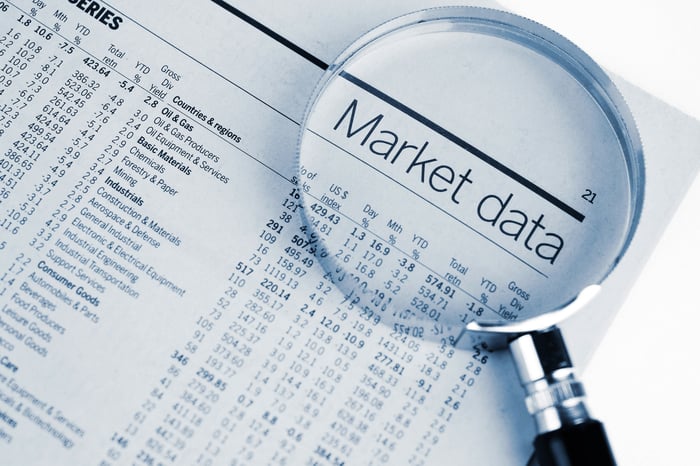Over the past three weeks, the stock market has sent investors a stern warning: Equities can go down, too.
Despite the benchmark S&P 500 (^GSPC -0.88%), iconic Dow Jones Industrial Average (^DJI 0.56%), and growth-oriented Nasdaq Composite (^IXIC -2.05%) reveling in record-breaking bounce-back rallies from the March 23, 2020, bear market low, the conditions are ripe for a stock market crash.
Since emotion is the primary driver of very short-term price movements, we're never going to know precisely when a crash or correction is coming. But make no mistake about it, crashes and corrections are an inevitable part of the investing cycle, and some would say the price of admission to the greatest wealth-creating tool on the planet.
With this in mind, here are six stock market crash metrics every investor should have in mind.

Image source: Getty Images.
1. A Shiller P/E greater than 30 leads to a bear market, historically
As noted, the market doesn't often give us telltale signs that a crash is coming. One of the very few indicators that, thus far, has a pretty immaculate track record of calling crashes is the Shiller S&P 500 price-to-earnings (P/E) ratio. It's a P/E ratio based on inflation-adjusted earnings from the previous 10 years.
Over the past 150 years, the average Shiller P/E reading is 16.79. As of March 3, 2021, the Shiller P/E stood at 34.59 -- more than double the historic average.
Here's where it gets interesting. There have been only five bull market rallies in history where the Shiller P/E for the S&P 500 surpassed 30 and held for a period of time. A few of these periods might ring a bell, such as the Great Depression, the dot-com bubble, and the coronavirus crash. Admittedly, the March 2020 crash had nothing to do with valuations and was purely a response to a once-in-a-generation pandemic. Nevertheless, it doesn't change the fact that the four previous instances of the Shiller P/E surpassing 30 have led to declines in the S&P 500 ranging between 20% and 89%.
In other words, history suggests that when the Shiller P/E heads above 30, a decline or a full-on bear market soon follows.

Image source: Getty Images.
2. Corrections occur every 1.87 years
No matter what sort of decline awaits investors in the future, it's important to recognize just how common these downward moves in the stock market are.
According to data from market analytics company Yardeni Research, there have been 38 declines of at least 10% in the widely followed S&P 500 since the beginning of 1950. Over this 71-year span, we're talking about a double-digit decline every 1.87 years, on average.
Keep in mind that averages are exactly that -- averages. There have been long periods in which corrections were few and far between. For example, there wasn't a single double-digit crash or correction between 1991 and 1996. By comparison, there have been seven double-digit percentage declines in the past 11 years, with at least eight other drops ranging from 5.8% to 9.9%.
Corrections are a healthy and normal occurrence.

Image source: Getty Images.
3. The average correction is six months long
Although corrections tend to bum out optimists, here's some good news: Most crashes and corrections don't last very long.
Dating back to 1950, 24 of the S&P 500's 38 double-digit percentage corrections have found their bottom in 104 or fewer calendar days (about 3.5 months). It took another seven between 157 and 288 calendar days to hit their trough. This means only seven significant declines in the market lasted longer than a year over the past seven-plus decades.
When we add those up, the S&P 500 has spent 7,168 days in correction since 1950. This works out to an average correction length of 188 days, or just over six months. Compare this figure to the 11-year bull market we just exited, and you can see why it pays to be an optimist.

Image source: Getty Images.
4. Modern-era corrections are a month shorter, on average
Cue the "but wait -- there's more" music.
Even though corrections and crashes have been relatively short-lived over the past 71 years, they're even shorter in the modern era. I'm defining "modern era" as the rise of computers, which have assisted immensely with trading and providing supply-demand balance to equities. I'm arbitrarily using 1985 as the beginning of this modern era.
Since 1985, the S&P 500 has undergone 16 double-digit declines. These include the dot-com bubble, which at 929 calendar days is the longest decline in the benchmark index's history. Even with this outlier, the average length of a crash or correction in the modern era is only 155 days. That's a full month shorter than the historical average for the broad-based index.
With the internet giving retail investors instant access to information, the barriers that once existed between Wall Street and Main Street have been torn down. This has played a key role in shortening the length of corrections and crashes.

Image source: Getty Images.
5. 70% of the market's worst days are followed by its best gains
Another interesting statistic that's bound to raise an eyebrow or two is the correlation between the stock market's best and worst days. While some folks might be tempted to run for cover at the first sign of trouble, history shows that this is the worst possible thing to do.
Last year, J.P. Morgan Asset Management released what's become an annual report that examines the rolling 20-year returns of the S&P 500. In particular, J.P. Morgan Asset Management looked at how investors' returns would differ if they missed only a handful of the market's best days over a 20-year period. Between Jan. 3, 2000, and Dec. 31, 2019, missing just the 20 best days would have effectively wiped out a 6% annual average return.
But what really stands out is how close the S&P 500's best and worst days occur to each other. According to the "Impact of Being Out of the Market" report, from Jan. 3, 2000, through April 19, 2020, "Seven of the ten worst days were followed the NEXT DAY [emphasis by J.P. Morgan Asset Management] by either top 10 returns over the 20 years or top 10 returns for their respective years."
If you try to game the market, you're the one that gets played.

Image source: Getty Images.
6. Long-term investors are batting 1.000
I saved the best stock market crash metric for last.
A bull market rally has eventually put each and every one of these 38 declines in the rearview mirror. And in many instances, it took just weeks or months to erase the declines. For practical purposes, it doesn't matter when you buy during a correction or crash. As long as you buy stakes in an assortment of high-quality, innovative businesses, and you hold those stocks for long periods of time, you have an exceptionally good chance of making money.
If you need further proof, data from Crestmont Research on the S&P 500 shows that at no point between 1919 and 2019 have rolling 20-year returns on the index ever been negative. In fact, only two ending years out of this 101-year period yielded average annual total returns (that is, including dividends) of less than 5%. If you buy with the intent of holding for a really long time, historical data suggests you're going to do very well.




